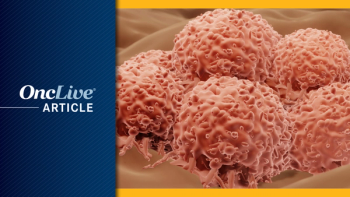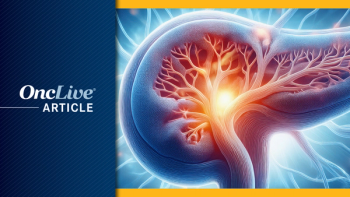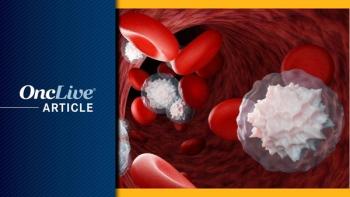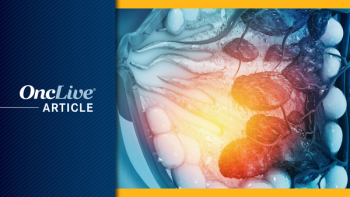
Pevonedistat/Azacitidine Demonstrates Improved Efficacy Vs Single-Agent Azacitidine in MDS
December 8, 2020 — Pevonedistat in combination with azacitidine improved overall survival and prolonged event-free survival compared with azacitidine monotherapy in patients with higher-risk myelodysplastic syndrome.
Pevonedistat in combination with azacitidine (Vidaza) improved overall survival (OS) and prolonged event-free survival (EFS) compared with azacitidine monotherapy in patients with higher-risk myelodysplastic syndrome (MDS), according to the results of the P-2001 trial, which were presented virtually during the 2020 ASH Annual Meeting & Exposition.
In the intention-to-treat population, EFS was 21.0 months in the combination arm compared with 16.6 months for the control arm (HR, 0.67; 95% CI, 0.42-1.05; P = .076). Median OS was 21.8 months in the treatment arm versus 19.0 months in the control arm (HR, 0.80; 95% CI, 0.51-1.26; P = .334).
“We conducted a post hoc analysis…of patients with MDS who are at high risk, according to the Cleveland Clinic model formula,” Mikkael A. Sekeres, MD, MS, director of the Leukemia Program in the Department of Hematologic Oncology and Blood Disorders at the Cleveland Clinic Taussig Cancer Institute in Ohio, said in a presentation of the data. The model incorporates weighted coefficients of variables significantly associated with OS such as age, IPSS-R (Revised International Prognostic Scoring System) score, and mutations in EZH2, SF3B1, and TP53.2 The post hoc analysis (n = 67) was presented during the conference.
In the phase 2, open-label trial, P-2001 (NCT02610777), 120 patients were randomized 1:1 to either the combination of pevonedistat (20 mg/m2) plus azacitidine (75 mg/m2) versus azacitidine alone. The study’s initial primary end point was EFS, defined as time to death or transformation to acute myeloid leukemia (AML), but this was changed to OS based on regulatory feedback. Pevonedistat is a first-in-class inhibitor of the NEDD8-activating enzyme. Inhibiting this enzyme blocks ubiquitination of select proteins upstream of the proteasome.
Baseline demographics and disease characteristics were generally balanced. Median age for the combination arm was 75 years (range, 47-91) and 70 years (range, 44-84) in the control arm. The majority of patients were male and the median time from initial diagnosis was 2.3 months (range, 0.2-58.4) in the combination arm and 1.74 months (range, 0.6-79.1) in the control arm.
The median EFS for patients with higher-risk MDS according to IPSS-R score was 20.2 months with the combination versus 14.8 months for patients in the control arm (HR, 0.539; 95% CI, 0.292-0.005; P = 0.45). Median OS was 23.9 months in the treatment arm versus 19.1 months in the control arm (HR, 0.701; 95% CI, 0.386-1.273; P = .240). “The difference in EFS was statistically significant, but the difference in OS was not,” Sekeres said. However, he pointed out that, “the trial was not powered to show differences in OS.” Longer EFS was particularly evident in patients with very high-risk MDS (n = 26; HR, 0.47; 95% CI, 0.19-1.18) and high-risk MDS (n = 21; HR, 0.53; 95% CI, 0.17-1.72).
According to the Cleveland Clinic formula, EFS was longer; although OS was longer as well, it failed to meet statistical significance in patients with high-risk MDS. Median EFS was 20.2 months in the treatment arm versus 11.7 months in the control arm (HR, 0.388; 95% CI, 0.166-0.902; P = .023) and median OS was 24.2 months in the treatment arm and 14.2 months in the control arm (HR, 0.447; 95% CI, 0.190-1.050; P = .056).
Regarding responses, the complete response (CR) rate for the treatment arm was nearly double the control arm (52% vs 27%) and the median duration of response for the combination arm was more than double that seen in the control arm (34.6 vs 13.1 months). Median time to first CR or partial response also favored the treatment arm (3.83 vs 4.29 months).
Sekeres said that the rate and duration of red blood cell and platelet transfusion independence was increased for patients who received the combination at 69.2% compared with the control arm at 47.4% (relative risk [RR], 1.46; 95% CI, 0.81-2.65; P = .228). Median duration of transfusion independence was 23.3 months for the treatment arm and 11.6 months for the control arm (HR, 0.11; 95% CI, 0.01-0.94; P = .016). Similarly, median time to AML transformation was delayed in patients with higher-risk MDS who received the combination treatment (P = 0.159).
“It’s important to focus on time to AML transformation,” Sekeres said. “We’re making the case that event-free survival, which incorporates both time to AML transformation and overall survival, is a clinically meaningful end point to focus on in trials of patients who have higher-risk MDS.”
AE rates were similar, and in some cases were lower, for those patients who received the combination compared with the control arm, particularly when they were normalized for the duration of treatment, Sekeres said.
“When we explore the efficacy of the combination in patients with higher-risk MDS who had poor-risk cytogenetics, we saw that combination was superior to the control treatment across a variety of risk mutations, including TP53,” Sekeres said.
Results of the P-2001 study demonstrated encouraging efficacy for the combination of pevonedistat and azacitidine versus azacitidine alone. “There was longer event-free survival and encouraging signals of overall survival with the combination versus the monotherapy,” concluded Sekeres.
References
- Sekeres MA, Watts J, Radinoff A, et al. Efficacy and safety of pevonedistat plus azacitidine vs azacitidine alone in higher-risk myelodysplastic syndromes (MDS) from study P-2001 (NCT02610777). Presented at: 62nd American Society of Hematology Annual Meeting and Exposition; December 5-8, 2020; virtual. Abstract 653.
- Nazha A, Narkhede M, Radivoyevitch T, et al. Incorporation of molecular data into the Revised International Prognostic Scoring System in treated patients with myelodysplastic syndromes. Leukemia. 2016;30(11):2214-2220. doi:10.1038/leu.2016.138

























































































